外文翻译--生产线平衡
- 格式:doc
- 大小:320.00 KB
- 文档页数:6
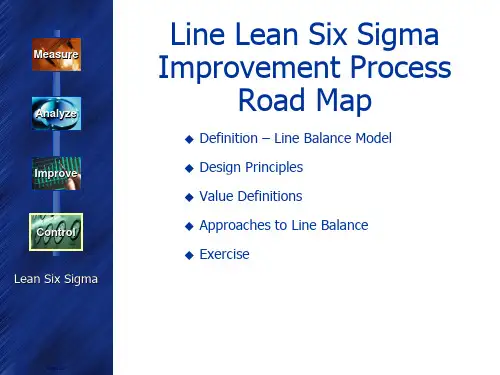
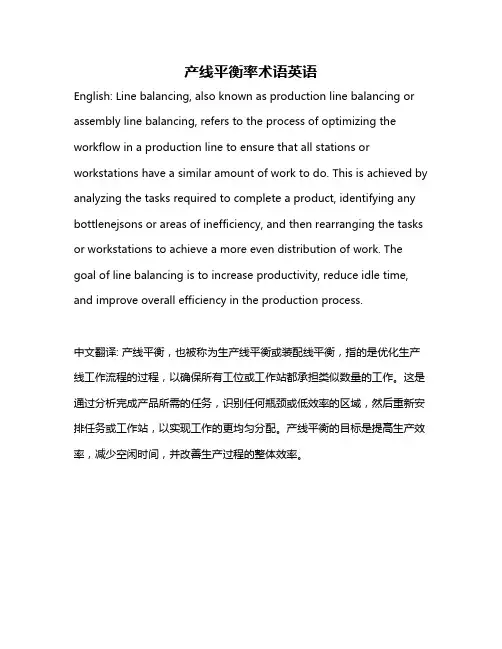
产线平衡率术语英语
English: Line balancing, also known as production line balancing or assembly line balancing, refers to the process of optimizing the workflow in a production line to ensure that all stations or workstations have a similar amount of work to do. This is achieved by analyzing the tasks required to complete a product, identifying any bottlenejsons or areas of inefficiency, and then rearranging the tasks or workstations to achieve a more even distribution of work. The goal of line balancing is to increase productivity, reduce idle time, and improve overall efficiency in the production process.
中文翻译: 产线平衡,也被称为生产线平衡或装配线平衡,指的是优化生产线工作流程的过程,以确保所有工位或工作站都承担类似数量的工作。
这是通过分析完成产品所需的任务,识别任何瓶颈或低效率的区域,然后重新安排任务或工作站,以实现工作的更均匀分配。
产线平衡的目标是提高生产效率,减少空闲时间,并改善生产过程的整体效率。
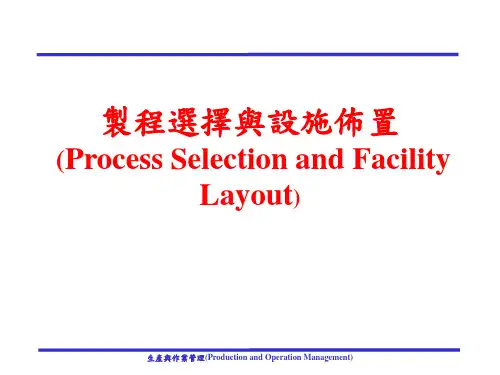
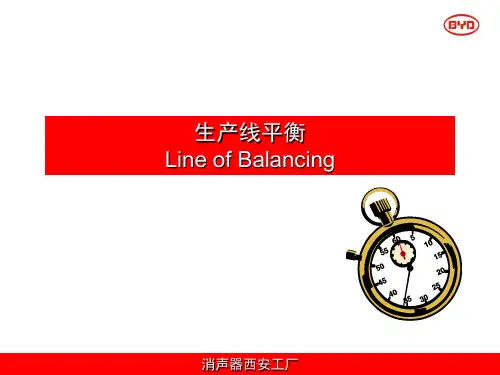
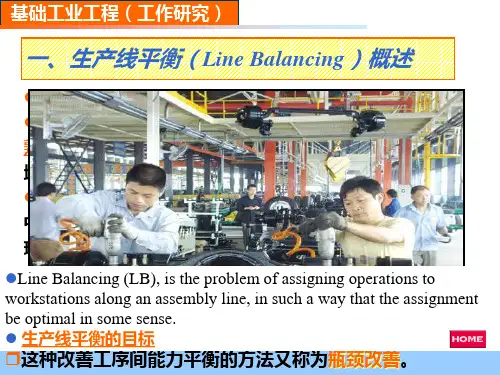
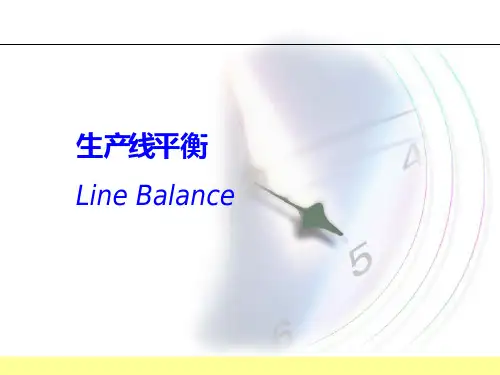
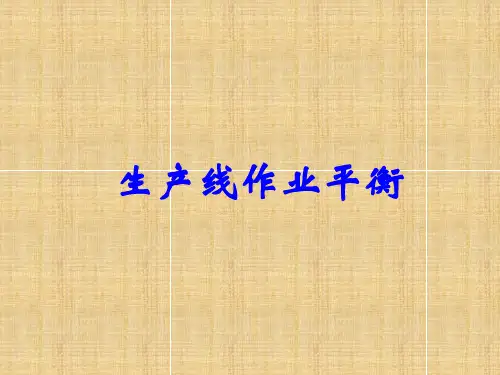
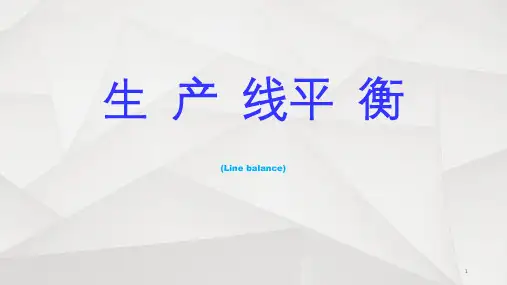
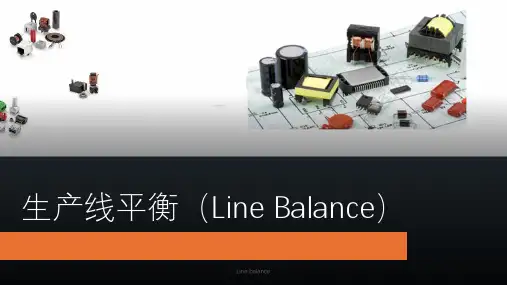
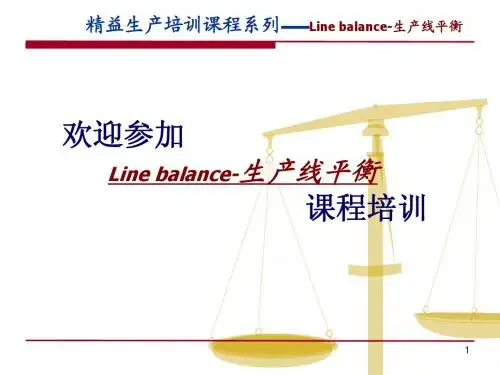
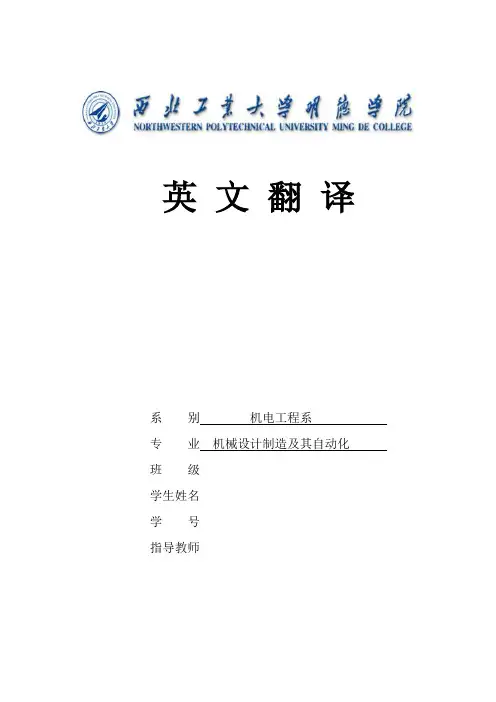
英文翻译系别机电工程系专业机械设计制造及其自动化班级学生姓名学号指导教师Production Line BalancingThe scope of this study is to explore the understanding of Productionline Manu-facturing and Balancing, Types of Line Balancing, Equipment Balancing and its Failure an-d Analysis.A production line is said to be in balance when every worker’s task takes the same amount of time. Line balancing is a manufacturing-engineering function in which whole collection of pr-oductionline tasks are divided into equal portions.Well-balanced lines avoid labour idealness and imp-rove productivity.Production Line BalancingLine-balancing strategy is to make production lines flexible enough to absorb ex-ternal and internal irregularities. There are two types of line balancing, which we have explained as:Static Balance Refers to long-term differences in capacity over a period of sever-al hours or longer. Static imbalance results in underutilization of workstations, machi-nes and people.Dynamic Balance Refers to short-term differences in capacity, like, over a perio-d of minutes, hours at most. Dynamic imbalance arises from product mix changes and variations in work time unrelated to product mix.Labour Balancing and AssignmentsStrategy of production line stability is the tendency for labour assignments to be f ixed. Labour feasibility is an important feature in the strategy of production line flex-i bility linked to individual skills and capabilitiesWhen one worker is having problem in performing his assigned task and experie-ncing delay due to technical problem(s), other worker(s) should move into help.The management practice of deliberately pulling worker’s of the line when the l-ine is running smoothly.The movement of whole crews from one dedicated line to another as the model mix changes.Group Technology – In which one worker can handle variety of tasks (automati-on) in a single work centre.Equipment BalancingWhile balancing equipment, attempt to ensure that each piece of equipment in th-e work cell has the same amount of work. Now days every manufacturer is attempting to maximize the utilization of all available equipments. Such high utilization is often co-unterproductive and may be the wrong goal because; high utilization is usually ac-companied by high inventory.Equipment FailureAn equipment failure is a major serious matter, with the potential to shut down a production line. To avoid such failures one should not overload the equipments, and workers should be trained to perform a daily machine checking (preventive maintena-nce) and following standard operating procedures. The advantage for Maintenance and Engineering.Department does not lie in running late shifts, hence calculate the pr-eventive maintenance time and schedule the activity.AnalysisAnalysis is generally performed by Competent Technical Staff. Begin the analys-is wi-th division of production-line work into small tasks, determination of task time s -tand-ards, specification of required task sequencing and notation of constraints. If bot t-le n-eck task is in the way of good balance, the Competent Technical Staff should an al-yze the task to reduce the time it takes to perform.Line Balancing LeadershipWorkmen should lead the production line balancing effort, so that they can react quickly when line imbalances (static and dynamic) crop up as a result of changeover to make a different item or changes in the output rate.ConclusionProduction-line balancing study tends to employ thought and ingenuity to change con-ditions. Production-line design and operation is more art than science. Labour fl-exibility is the key to effective resource management. The idea of workers checking and doing minor repair work on their own equipment possibly decreases the risk of e-quipment failure. Selecting an appropriate set of balancing mechanism is a part of wo-rk cell design and it must be linked with many other decisions for the system to func-tion well.生产线平衡这项研究的范围是探讨生产线的制造和平衡,生产线平衡的类型,设备平衡和故障分析的理解。
生产线平衡(line balance)什么是生产线平衡生产线平衡是依照流水线作业的工程顺序,以生产目标算出周期时间,将作业分割或者结合,使各个工序的负荷均匀,以提高生产效率的方法。
一个产品,少则两三个工程,多则几十个,而每个工程又是由多个作业要素所组成,在生产工场里,制造部门依物料的加工流程分为一组、二组、三组,而每组内又由许多的个别工序所组成,所以又把它联结成一条条的生产线。
生产线平衡的相关概念流程的“节拍”(Cycle time)是指连续完成相同的两个产品(或两次服务,或两批产品)之间的间隔时间。
换句话说,即指完成一个产品所需的平均时间。
节拍通常只是用于定义一个流程中某一具体工序或环节的单位产出时间。
如果产品必须是成批制作的,则节拍指两批产品之间的间隔时间。
在流程设计中,如果预先给定了一个流程每天(或其它单位时间段)必须的产出,首先需要考虑的是流程的节拍。
而通常把一个流程中生产节拍最慢的环节叫做“瓶颈“。
流程中存在的瓶颈不仅限制了一个流程的产出速度,而且影响了其它环节生产能力的发挥。
更广义地讲,所谓瓶颈是指整个流程中制约产出的各种因素。
例如,在有些情况下,可能利用的人力不足、原材料不能及时到位、某环节设备发生故障、信息流阻滞等,都有可能成为瓶颈。
正如“瓶颈”的字面含义,一个瓶子瓶口大小决定着液体从中流出的速度,生产运作流程中的瓶颈则制约着整个流程的产出速度。
瓶颈还有可能“漂移”,取决于在特定时间段内生产的产品或使用的人力和设备。
因此在流程设计中和日后的日常生产运作中都需要引起足够的重视。
与节拍和瓶颈相关联的另一个概念是流程中的“空闲时间”空闲时间是指工作时间内没有执行有效工作任务的那段时间,可以指设备或人的时间。
当一个流程中各个工序的节拍不一致时,瓶颈工序以外的其它工序就会产生空闲时间。
这就需要对生产工艺进行平衡。
制造业的生产线多半是在进行了细分之后的多工序流水化连续作业生产线,此时由于分工作业,简化了作业难度,使作业熟练度容易提高,从而提高了作业效率。
生产线平衡(line balance)什么是生产线平衡生产线平衡是依照流水线作业的工程顺序,以生产目标算出周期时间,将作业分割或者结合,使各个工序的负荷均匀,以提高生产效率的方法。
一个产品,少则两三个工程,多则几十个,而每个工程又是由多个作业要素所组成,在生产工场里,制造部门依物料的加工流程分为一组、二组、三组,而每组内又由许多的个别工序所组成,所以又把它联结成一条条的生产线。
流程的“节拍”(Cycle time)是指连续完成相同的两个产品(或两次服务,或两批产品)之间的间隔时间。
换句话说,即指完成一个产品所需的平均时间。
节拍通常只是用于定义一个流程中某一具体工序或环节的单位产出时间。
如果产品必须是成批制作的,则节拍指两批产品之间的间隔时间。
在流程设计中,如果预先给定了一个流程每天(或其它单位时间段)必须的产出,首先需要考虑的是流程的节拍。
而通常把一个流程中生产节拍最慢的环节叫做“瓶颈“。
流程中存在的瓶颈不仅限制了一个流程的产出速度,而且影响了其它环节生产能力的发挥。
更广义地讲,所谓瓶颈是指整个流程中制约产出的各种因素。
例如,在有些情况下,可能利用的人力不足、原材料不能及时到位、某环节设备发生故障、信息流阻滞等,都有可能成为瓶颈。
正如“瓶颈”的字面含义,一个瓶子瓶口大小决定着液体从中流出的速度,生产运作流程中的瓶颈则制约着整个流程的产出速度。
瓶颈还有可能“漂移”,取决于在特定时间段内生产的产品或使用的人力和设备。
因此在流程设计中和日后的日常生产运作中都需要引起足够的重视。
与节拍和瓶颈相关联的另一个概念是流程中的“空闲时间”空闲时间是指工作时间内没有执行有效工作任务的那段时间,可以指设备或人的时间。
当一个流程中各个工序的节拍不一致时,瓶颈工序以外的其它工序就会产生空闲时间。
这就需要对生产工艺进行平衡。
制造业的生产线多半是在进行了细分之后的多工序流水化连续作业生产线,此时由于分工作业,简化了作业难度,使作业熟练度容易提高,从而提高了作业效率。
- -本科毕业论文外文翻译外文译文题目:对于E类型的简单生产线平衡问题的解决过程学院: 机械自动化专业: 工业工程学号: 20108学生: 谭指导教师:日期: 二○一四年五月A solution procedure for type E simple assembly linebalancing problemNai-Chieh Wei , I-Ming ChaoIndustrial Engineering and Management,I-Shou University, No. 1, Section 1, Syuecheng Rd. Dashu District, Kaohsiung City84001, Taiwan, ROC.对于E类型的简单生产线平衡问题的解决过程Nai-Chieh Wei , I-Ming Chao工业工程与管理,中华人民国,省,高雄市,Syuecheng Rd.Dashu街一号,义守大学,第一章第一节- -摘要本文提出了结合SALBP-1和SALBP-2的E型简单装配线平衡问题〔SALBP-E〕,更多的,本研究为提出的模型提供了解决方法。
提出的模型在最小化空闲时间的同时优化装配线平衡率,为管理实践提供了更好的理解,计算结果说明:给出周期的上限ct以后,提出的模型可以最优的解决问题,因为它含有最少的变量,约max束和计算时间。
1前言从研究者第一次讨论装配线平衡问题以来,大约有50年了,在众多有关生产线平衡问题中,最根本的是简单装配线平衡问题,早在1954年,Bryton就定义并且研究了生产线平衡问题。
后一年,Salverson建立了第一个生产线平衡的数学模型并提出了定性的解决步骤,这引来了很大的兴趣,在Gutjahr 和Nemhauser说明生产线平衡是一种NP组合优化难题,大多数研究者希望开发一种能高效解决多种装配线问题的方法。
在随后的几年,生产线平衡成为了一个流行的主题,Kim, Kim, and Kim (1996) 把生产线平衡分为五类问题,其中的问题1〔SALBP-1〕和问题Ⅱ(SALBP-Ⅱ)是两种根本的优化问题。
毕业设计(论文)外文资料翻译学院:经济管理学院专业:工业工程姓名:学号:外文出处: 附件: 1.外文资料翻译译文;2.外文原文。
(用外文写)生产线平衡这项研究的范围是探讨生产线的制造和平衡,生产线平衡的类型,设备平衡和故障分析的理解。
当每个工人的任务需要相同的时间来完成的时候,就是一个平衡的流水线。
线平衡,是一个制造工程的功能,即在整个生产线的任务都能够得到等分。
良好的平衡线,能避免无意义的劳动和提高生产效率。
生产线平衡线平衡的策略是,使生产线足够灵活,以避免外部和内部的违规行为。
有两种类型的生产线平衡,即:静态平衡:指的是几个小时或更长的时间内能力的长期分歧。
静态失衡是工作站,机器和人未能得到充分利用的结果。
动态平衡:指短期能力的差异,最多不超过几分钟或几个小时的时间。
动态不平衡源于产品结构的变化和产品结构无关的工作时间的变化。
劳资平衡和分配生产线的稳定策略的倾向是固定的劳动的平衡分配。
劳资的可行性的一个重要特征是战略的灵活性即生产线的个人技能和能力:当一名工人在执行分配给他的任务是有问题,遇到的延迟,由于技术问题(S),其他工人(S)应转移到帮助。
当一个工序运行出现问题时,熟练的技工应尽快接管其工序。
生产线的所有工人应交互在各个工序熟悉工序操作。
全技能即在一个单一的工作中心一个工人可以处理各种任务(自动化)。
设备平衡设备平衡应确保每一台设备在工作单元中有相同的工作量。
现在每个制造商都试图最大限度地利用所有可用的设备。
如此高的利用率往往适得其反,这可能是一个错误的目标,因为利用率高,通常伴随着高库存。
设备故障设备故障是一项重大而严肃的问题,有可能关闭一条生产线。
为了避免这种故障,应确保每个设备不会超载,并且应培训工人进行日常机器检查(预防性维护)和标准作业程序的训练。
维护部和工程部的优势不在于在运行后期的变化,因此应计算预防性维修时间,并安排活动。
分析线平衡的分析一般由主管技术人员进行。
分析之前应把流水线分成各个小任务,确定标准的任务时间,任务的排序的规范和约束的分析与生产线的工作分工。
如果瓶颈环节的任务是在于寻找良好的平衡的方式,技术过硬的员工应分析的任务,以减少所花费的时间来执行。
生产线平衡领导生产线工人应致力于生产线平衡而努力,这样他们才能够快速应对当产品和生产率变换导致失衡(静态和动态)时迅速作出反应。
结论生产线平衡的研究,往往聘请有新思路和经验的人来改变现状。
生产线的设计和操作是艺术多于科学。
工人的灵活性是有效的资源管理的关键所在。
工人的检查和对自己的设备做小型维修工作的想法可能降低了设备故障的风险。
选择一套合适的平衡机制是一个工作单元设计的一部分,它必须与许多其他决策系统建立良好的联系才能运作良好。
Production Line BalancingThe scope of this study is to explore the understanding of Production-line Manufacturing and Balancing, Types of Line Balancing, Equipment Balancing and its Failure and Analysis. A production line is said to be in balance when every worker’s task takes the same amount of time. Line balancing is a manufacturing-engineering function in which whole collection of production-line tasks are divided into equal portions. Well-balanced lines avoid labour idealness and improve productivity.Production Line BalancingLine-balancing strategy is to make production lines flexible enough to absorb external and internal irregularities. There are two types of line balancing, which we have explained as:∙Static Balance – Refers to long-term differences in capacity over a period of several hours or longer. Static imbalance results in underutilizationof workstations, machines and people.∙Dynamic Balance – Refers to short-term differences in capacity, like, over a period of minutes, hours at most. Dynamic imbalance arises fromproduct mix changes and variations in work time unrelated to product mix.Labour Balancing and AssignmentsStrategy of production line stability is the tendency for labour assignments to be fixed. Labour feasibility is an important feature in the strategy of production line flexibility linked to individual skills and capabilities –∙When one worker is having problem in performing his assigned task and experiencing delay due to technical problem(s), other worker(s) shouldmove into help.∙The management pr actice of deliberately pulling worker’s of the line when the line is running smoothly.∙The movement of whole crews from one dedicated line to another as the model mix changes.Group Technology – In which one worker can handle variety of tasks (automation) in a single work centre.Equipment BalancingWhile balancing equipment, attempt to ensure that each piece of equipment in the work cell has the same amount of work. Now days every manufacturer is attempting to maximize the utilization of all available equipments. Such high utilization is often counterproductive and may be the wrong goal because; high utilization is usually accompanied by high inventory.Equipment FailureAn equipment failure is a major serious matter, with the potential to shut down a production line. To avoid such failures one should not overload the equipments, and workers should be trained to perform a daily machine checking (preventive maintenance) and following standard operating procedures. The advantage for Maintenance and Engineering Department does not lie in running late shifts, hence calculate the preventive maintenance time and schedule the activity.AnalysisAnalysis is generally performed by Competent Technical Staff. Begin the analysis with division of production-line work into small tasks, determination of task time standards, specification of required task sequencing and notation of constraints. If bottle neck task is in the way of good balance, the Competent Technical Staff should analyze the task to reduce the time it takes to perform.Line Balancing LeadershipWorkmen should lead the production line balancing effort, so that they can react quickly when line imbalances (static and dynamic) crop up asa result of changeover to make a different item or changes in the output rate.ConclusionProduction-line balancing study tends to employ thought and ingenuity to change conditions. Production-line design and operation is more art than science. Labour flexibility is the key to effective resource management. The idea of worker’s checking and doing minor repair work on their own equipment possibly decreases the risk of equipment failure. Selecting an appropriate set of balancing mechanism is a part of work cell design and it must be linked with many other decisions for the system to function well.。